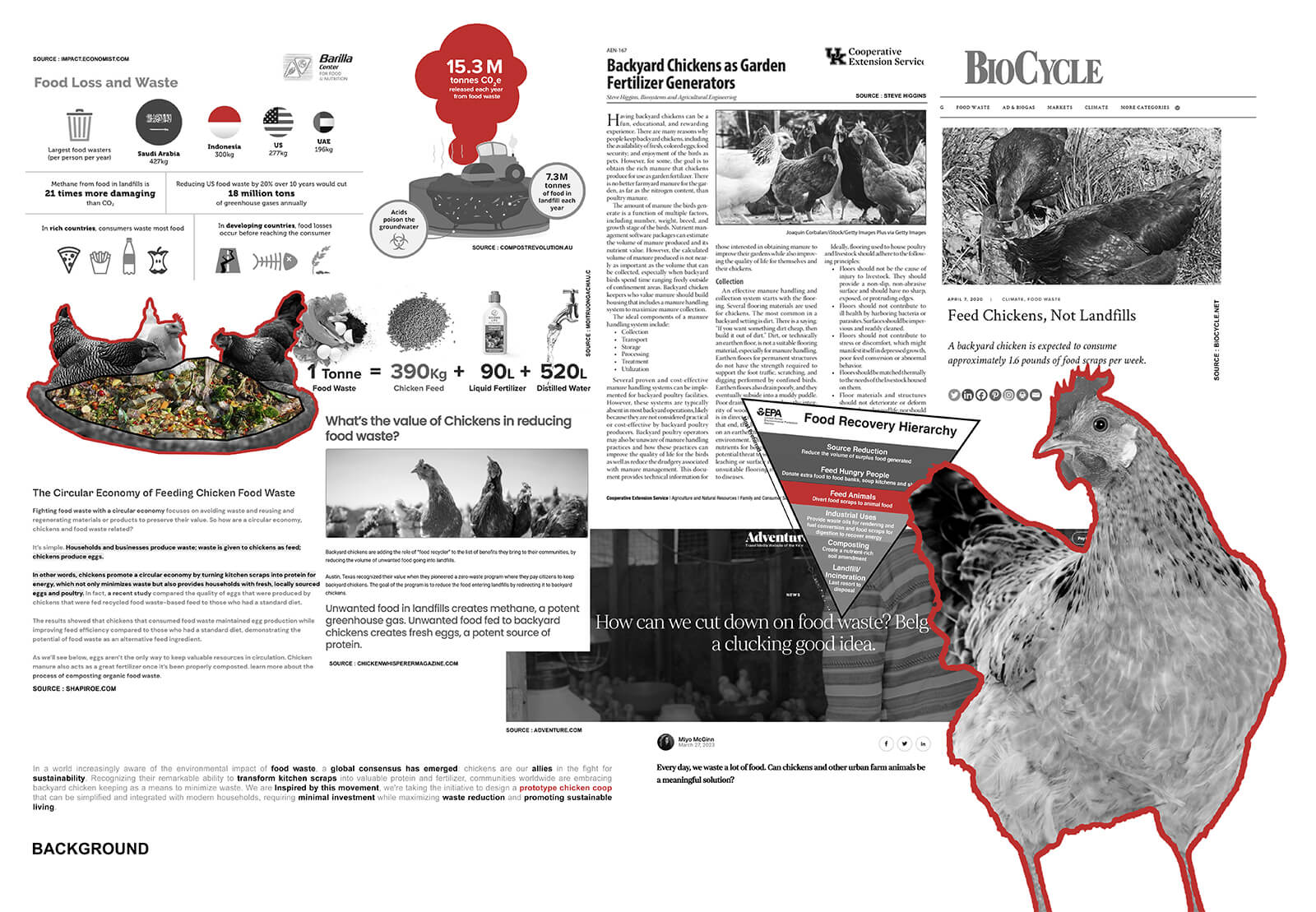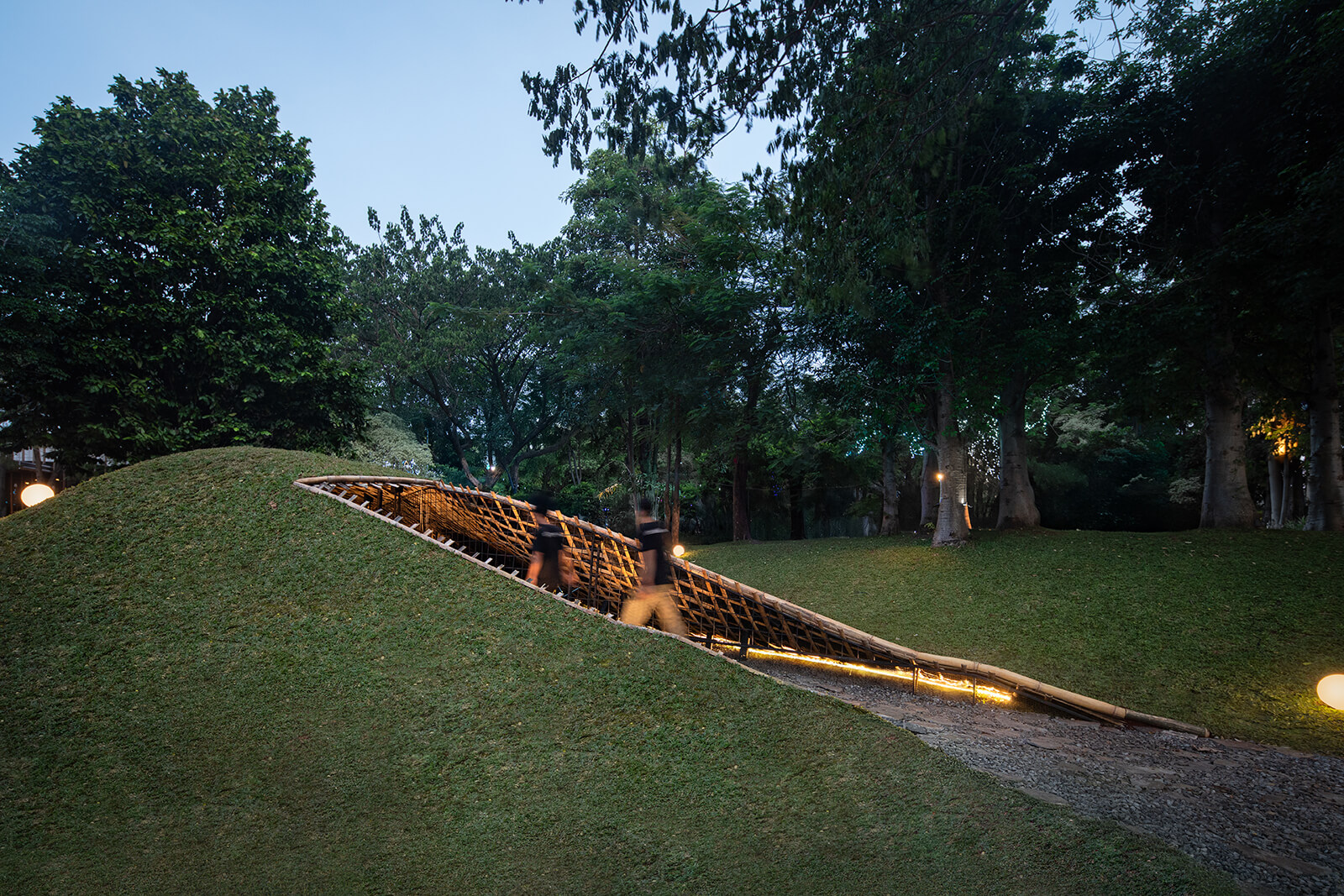Greening the urban grid with RAD+ar’s Aruma Split Garden
by Aarthi MohanJul 20, 2024
•make your fridays matter with a well-read weekend
by Aarthi MohanPublished on : Jan 23, 2025
How can local initiatives inspire sustainable solutions for global challenges? The Chicken Hero Pavilion in Urban Forest Jakarta is one such example, addressing food waste and sustainable farming through an inventive approach. Designed by RAD+ar, the pavilion blends seamlessly into the park's hilly landscape, resembling another hill, and houses an inclusive educational and entertainment space called the chicken coop. This self-initiated project champions independent backyard poultry farming as a way to reduce household and community food waste, a pressing issue in Indonesia, which ranks as the world's second-largest producer of food waste, generating an estimated 1.6 million tonnes annually, which is roughly 300kg per person.
Central to the pavilion architecture is its prototype of upcycled, eco-friendly chicken coop designs. These coops prioritise environmental sustainability without compromising functionality or comfort. It features a cave-like tunnel with cross-ventilated interiors, ensuring optimal airflow and stable thermal conditions for the chickens. The indirect daylighting and reclaimed bamboo used in the horizontal-diagonal green roof structure enhance its eco-friendly design. Additionally, the pavilion serves as a rainwater catchment area, contributing to Jakarta's green initiatives while maintaining the balance between environmental preservation and urban functionality.
Beyond its architectural ingenuity, the pavilion design underscores a practical circular economy model. Over its four-week display, it operated as a food waste processor for six on-site restaurants. Organic waste, such as dried leaves and food scraps, was repurposed as chicken bedding, reducing humidity and facilitating composting. The compost produced was harvested every three days and used for gardening and commercial purposes. Meanwhile, the chickens provided approximately 40 eggs daily, distributed back to the participating restaurants and offered as souvenirs for visitors. This closed-loop system demonstrates how small-scale interventions can achieve significant sustainability outcomes.
The Chicken Hero Pavilion also emphasises inclusivity and education. Its design creates a welcoming space for visitors, fostering interaction between people and chickens. This reciprocity is not merely symbolic; it serves to break down the stigma associated with home-based poultry keeping. By engaging visitors and providing tangible examples of sustainable practices, the bamboo pavilion aims to inspire communities to adopt similar initiatives in their households and neighbourhoods.
One of the pavilion's standout features is its simplicity of construction. The design complements the natural surroundings of the forest while creating accessible public spaces. The use of reclaimed bamboo and other sustainable materials demonstrates how construction can be both eco-friendly and cost-effective. Its temporary nature underscores its experimental character, showcasing the feasibility of sustainable solutions in urban planning without requiring permanent infrastructure.

At its core, the project tackles a broader question: how can sustainability be decentralised across a developing nation? Indonesia’s archipelagic geography presents unique challenges and opportunities. The concept of ‘Glocalization’, a blend of globalisation and localisation, is central to its philosophy. By promoting micro-circular economies within communities, the design aligns global sustainability goals with local practices. This approach is particularly relevant in Indonesia, where diverse cultures and geographic conditions necessitate localised solutions.
The pavilion’s workshops and interactive exhibits don’t just educate visitors; they empower them. By demonstrating practical techniques for waste management and eco-friendly farming, the project has created ripple effects that extend beyond its physical boundaries.
RAD+ar’s vision for the pavilion is ambitious yet grounded. The project serves as a blueprint for decentralising sustainability, providing a roadmap for government bodies and developers to integrate similar models into broader urban planning efforts. Its focus on small-scale, community-driven solutions reflects a pragmatic approach, one that recognises the limitations and potential of a developing country.
The Bali -based practice has built a reputation for pushing the boundaries of sustainable and contextual design through a range of innovative projects like the Tanatap Frame Garden that epitomises façade-less living by creating harmonious connections between space, nature and community. The Aruma Split Garden employs split-level designs and integrated greenery to transform urban areas into serene oases, balancing leisure and education. Similarly, the Pusaran Ocean Deck introduces a floating deck design that enhances public spaces with its cultural sensitivity and environmental mindfulness.
The pavilion’s success lies in its ability to address multiple challenges simultaneously. It reduces food waste, promotes sustainable farming and fosters community engagement. By integrating these elements into a cohesive design, the Chicken Hero Pavilion exemplifies how architecture can be both functional and transformative. It serves as a reminder that even modest interventions can have far-reaching impacts when aligned with broader sustainability goals.

The pavilion is a microcosm of RAD+ar’s innovative ethos. By creating a space where education, sustainability, and interaction converge, the pavilion offers a hopeful vision for the future, one where small-scale initiatives spark meaningful change. As Indonesia continues to confront the challenges of food waste and urbanisation, projects like this remind us that solutions often lie in the synergy of creativity and local action.
Name: Chicken Hero Pavilion
Office Name: RAD+ar
Firm Location: Bali, Indonesia
Gross Built Area (m2/ ft2): 900 sq m
Project Location: Urban Forest Jakarta
Program / Use / Building Function: Pavilion
Lead Architects: Antonius Richard Rusli, Daniel Susanto
Completion Year: 2024
by Jerry Elengical Oct 08, 2025
An exhibition about a demolished Metabolist icon examines how the relationship between design and lived experience can influence readings of present architectural fragments.
by Anushka Sharma Oct 06, 2025
An exploration of how historic wisdom can enrich contemporary living, the Chinese designer transforms a former Suzhou courtyard into a poetic retreat.
by Bansari Paghdar Sep 25, 2025
Middle East Archive’s photobook Not Here Not There by Charbel AlKhoury features uncanny but surreal visuals of Lebanon amidst instability and political unrest between 2019 and 2021.
by Aarthi Mohan Sep 24, 2025
An exhibition by Ab Rogers at Sir John Soane’s Museum, London, retraced five decades of the celebrated architect’s design tenets that treated buildings as campaigns for change.
 surprise me!
surprise me!
make your fridays matter
SUBSCRIBEEnter your details to sign in
Don’t have an account?
Sign upOr you can sign in with
a single account for all
STIR platforms
All your bookmarks will be available across all your devices.
Stay STIRred
Already have an account?
Sign inOr you can sign up with
Tap on things that interests you.
Select the Conversation Category you would like to watch
Please enter your details and click submit.
Enter the 6-digit code sent at
Verification link sent to check your inbox or spam folder to complete sign up process



by Aarthi Mohan | Published on : Jan 23, 2025
What do you think?